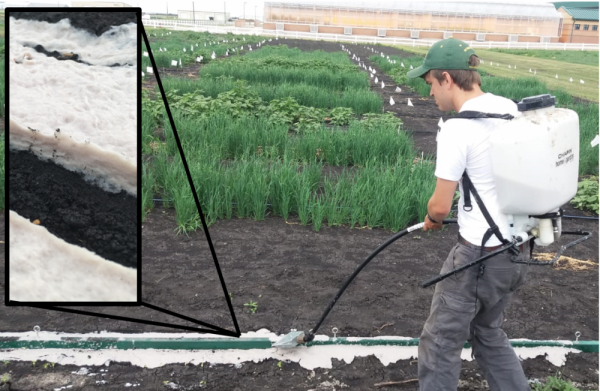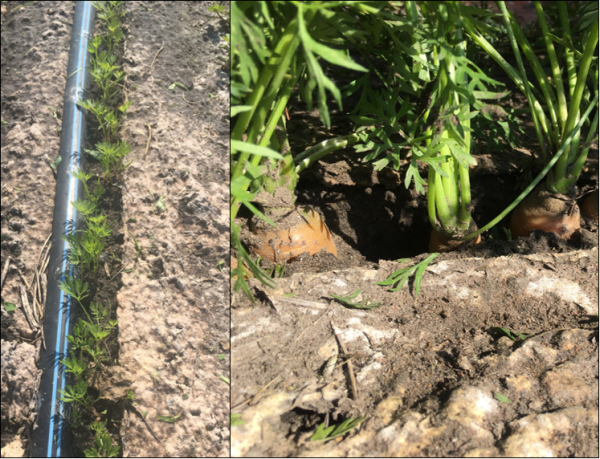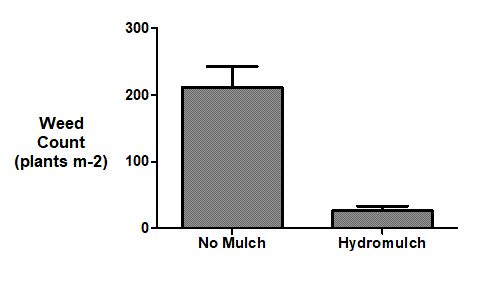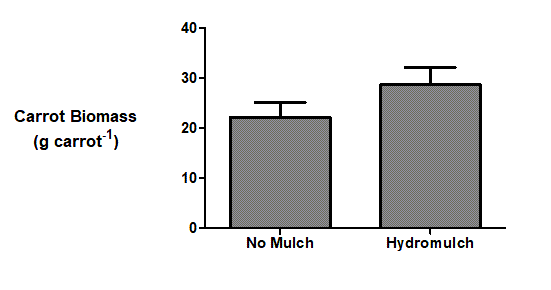eOrganic authors:
Jesse Puka-Beals, North Dakota State University
Greta Gramig, North Dakota State University
Introduction
Mulching suppresses weeds without soil disturbance and can provide soil moisture and temperature modifications that are beneficial to crop growth. Most agricultural mulches are made of polyethylene, a black plastic that is lightweight, easy to apply, and improves vegetable yields for early-season and heat-loving crops (Shogren and Hochmuth, 2004). The need for biodegradable mulch materials in organic production has been well articulated in previous eOrganic articles (Corbin et al., 2019; Schonbeck et al., 2015). Multiple emerging biodegradable mulch products are being developed and evaluated at land grant universities, but currently only paper mulches meet NOP standards (Andrews et al., 2015).
Paper mulches have been in agricultural production at least since the early twentieth century (Clark and Elizabeth, 1931). The use of Kraft paper coated with vegetable oil can achieve similar levels of weed control as current plastic mulches (Cirujeda et al., 2012; Shogren and Hochmuth, 2004). The yearly purchase of oil-coated Kraft paper, however, may not be feasible for some small-scale organic vegetable producers. The (re)use of newspapers as a paper mulch, on the other hand, may provide a readily available and lower-cost alternative. Newspaper and shredded newspaper were investigated for weed control, with shredded newspaper providing the best weed control within high tunnels for cucumber (Cucumis sativus) production (Sánchez et al., 2008).
Paper mulches, however, present numerous drawbacks that limit their adoption. Susceptibility to wind damage is a primary issue with paper mulches observed in Florida (Warnick et al., 2006). Another concern is the immobilization of soil nitrogen as the paper mulches are degraded by soil microbes, releasing high amounts of carbon into the soil. To address these drawbacks, we applied newspaper mulches in strip till zones within living mulches that could both provide protection from wind and enhance soil nitrogen through atmospheric fixation. Additionally, we suspended our newspaper-mulch in water and applied it as a slurry, a practice known as hydromulching.
The use of hydromulches, foam mulches, hydraulic mulches or hydramulches can provide an effective application method for paper mulches. Unlike solid mulches, which come in pre-cut dimensions, liquid mulches can be applied at any given width and can be well suited for strip-till zones within living mulches.
Limited mulching options exist for vegetable crops that cannot be transplanted, such as carrots. The use of hydromulches may provide better coverage between crops than a plastic mulch. The use of only newspaper and water could provide organic vegetable producers a low-cost method that aligns with NOP standards. Here we present some preliminary research results for hydromulching in carrot production in North Dakota.
IMPORTANT: Before using any product in your organic farming system:
- Read the label to be sure that the product is labeled for the crop and pest you intend to control, and make sure it is legal to use in the state, county, or other location where it will be applied.
- Read and understand the safety precautions and application restrictions.
- Make sure that the brand name product is listed in your Organic System Plan and approved by your USDA-approved certifier. If you are trying to deal with an unanticipated pest problem, get approval from your certifier before using a product that is not listed in your plan—doing otherwise may put your certification at risk.
Note that, although OMRI and WSDA lists are good places to identify potentially useful products, all products that you use must be approved by your certifier. For more information on how to determine whether a pest control product can be used on your farm, see the article, Can I Use This Input On My Organic Farm?
Materials and Application
The newspaper was acquired prior to printing in rolls (S-1079, Uline, WI). The newspaper was either shredded using a paper shredder or cut using scissors. The newspaper was combined with water at a ratio of 1 kg to 35 L and blended into a smooth consistency using an industrial blender for small volumes and a TurboTurf Hydroseeding Unit for larger volumes (TurboTurf Hydroseeding Unit Model# HS-100,Beaver Falls, PA, USA). Hydromulch was gravity fed onto the soil surface with flexible water supply tubes that were kept less than 5 cm above the soil surface to reduce soil disturbance (Fig. 1, Fig. 2). The hydromulch had a height of 2 cm after application.

Figure 1. Hydromulch application immediately following direct seeding of carrot within strip till zones of living mulch.

Figure 2. Practicing a hydromulch application before application in the experiment. Hydromulch from the backpack is poured onto the green C-channel bar, then the bar is removed to allow for a slit of bare soil for the carrot to emerge. Photo Credit: Kris Boll, North Dakota State University.
In the reported experiment, hydromulch was applied directly after seeding the crop by placing a C-channel steel bar directly over where the carrot seed was planted so that a slit would exist within the hydromulch where the carrot could emerge (Fig. 3). Hydromulch could also be applied after the crop emerges (Fig. 4) or after thinning a direct seeded crop, but these approaches were outside the scope of the current experiment.

Figure 3. Carrots emerging through a slit in the hydromulch produced from the C-channel bar. The hydromulch color has become darker after rain and sun exposure. Carrots were irrigated during emergence (left image) and then drip tape was removed later in the season (right image). Photo credit: Jesse Puka-Beals, North Dakota State University.

Figure 4. Hydromulch applied after emergence in beans (Phaseolus vulgaris). Here the hydromulch is able to flow in-between the emerged plants for full soil coverage. This photo is not from the experiment, but from an adjacent area where hydromulch applications were practiced before use in the experiment. Photo credit: Jesse Puka-Beals, North Dakota State University.
The experiment was conducted over two years (2018, 2019) and at two locations in North Dakota (Absaraka and Fargo). There were 40 plots at each site that either received hydromulch or a no-mulch control in the strip-till zone. Strip-till zones were also embedded within one of five different living mulch treatments: red clover (Trifolium pratense), white clover (Trifolium repens), perennial ryegrass (Lolium perenne), a weed-free control, and a weedy control.
Data was analyzed using Generalized Linear Mixed Models to detect whether interactions between years and locations would prevent combining the weed or yield responses using SAS (Cary, NC). Carrot yield was reported on a biomass carrot-1 basis rather than total biomass per plot due to variations in carrot stand density which were not detected to be associated with any experimental treatments.
Weed Suppression
Weed response was consistent over both locations and growing seasons. Weed count was reduced by 88% (Fig. 5), and weed biomass was reduced by 85% when hydromulch was applied compared to the no-mulch control (Fig. 6). Weed species that did emerge in the hydromulch were often the result of small holes that formed later in the growing season and may have emerged after the critical weed-free period for carrots. Carrots grown under hydromulch were 29% larger than the carrots without hydromulch, but variation in carrot size among sites and years makes it possible that these differences are due to random chance and may be a result of the hydromulch (Fig. 7).

Figure 5. Weed count measurements taken before carrot harvest, combined across both years and sites. Bar graphs represent means, and error bars represent standard error. No interaction among years or sites was detected when using a Generalized Linear Mixed Model in SAS (Cary, NC).

Figure 6. Weed biomass measurements taken before carrot harvest, combined across both years and sites. The roots of these weeds were washed and dried in an oven to constant mass to ensure comparison of weed biomass rather than weed biomass + water content. Bar graphs represent means, and error bars represent standard error. No interaction among years or sites was detected when using a Generalized Linear Mixed Model in SAS (Cary, NC).

Figure 7. Average carrot biomass in the no-mulch and hydromulch treatments.
The newspaper hydromulch was vulnerable to certain field conditions. If a heavy rainfall occurred before complete drying of the hydromulch, damage occurred. If the weather was humid and overcast, drying could take 3 days. The use of newsprint prior to printing likely improved the cohesion and integrity of the mulch compared to post-consumer newspapers (Claramunt et al., 2020). In treatments where living mulches were not present, heavy winds could separate the hydromulch from the soil surface. Of the 16 hydromulch plots that were not within a living mulch, 2 were partially displaced by wind at some point during the field season. Of the remaining 64 hydromulch treatments applied within living mulches, no wind displacement was observed.
Conclusions
This preliminary project did not attempt to directly compare newspaper hydromulching with plastic mulching. It is well established that plastic mulches are effective at weed control, but plastic mulches cannot be easily applied within the strip till zones of the experiment. The objective of the current work was to determine whether a newspaper hydromulch could be effectively applied and provide weed control during the duration of two growing seasons in two locations in North Dakota. Hydromulch application significantly reduced weed counts and biomass. Minor degradation of the hydromulch was observed over the course of the experiment, but weed control was achieved that would be adequate for many vegetable growers, based on discussions with farmer-collaborators and at field-day visits. However, this was just one study and results are not intended to be applicable to all vegetable operations or weed control situations. Many questions remain concerning potential materials that could be used for hydromulches, application methods, and the impacts of biodegradation within the soil. Further development of hydromulching could provide a useful addition to the organic farmer's weed control toolkit.
References and Citations
- Andrews, L., L. Devetter, C. Miles. 2015. Biodegradable mulch update—new NOP rule [Online]. Oregon State University Extension. Available at: https://extension.oregonstate.edu/crop-production/field-crops/biodegradable-mulch-update-new-nop-rule. (verified 3 Sep 2020).
- Cirujeda, A., J. Aibar, A. Anzalone, L. Martín-Closas, R. Meco, M. M. Moreno, A. Pardo, A. M. Pelacho, F. Rojo, A. Royo-Esnal, M. L. Suso, and C. Zaragoza. 2012. Biodegradable mulch instead of polyethylene for weed control of processing tomato production. Agronomy for Sustainable Development 32:889—897. (Available online at: https://link.springer.com/article/10.1007%2Fs13593-012-0084-y) (verified 3 Sep 2020).
- Claramunt J., M. T. Mas, G. Pardo, A. Cirujeda, and A.M.C. Verdu. 2020. Mechanical characterization of blends containing recycled paper pulp and other lignocellulosic materials to develop hydromulches for weed control. Biosystems Engineering 191:35—47. (Available online at: https://doi.org/10.1016/j.biosystemseng.2019.12.012) (verified 3 Sep 2020).
- Clark, H., P. Elizabeth. 1931. Farming under paper. Farming in South Africa 5:557—558. (Available online at: https://journals.co.za/docserver/fulltext/farmsa/5/60/809.pdf?expires=1599174517&id=id&accname=guest&checksum=9252FF482BD785D4A282A3F639BD6EA9 (verified 3 Sep 2020).
- Corbin, A. T., C. A. Miles, J. Cowan, D. G. Hayes, J. Moore-Kucera, and D. A. Inglis. 2019. Current and future prospects for biodegradable plastic mulch in certified organic production systems [Online]. eOrganic article. Available at: https://eorganic.org/node/8260) (verified 3 Sep 2020).
- Sánchez, E., W. J. Lamont, and M. D. Orzolek. 2008. Newspaper mulches for suppressing weeds for organic high-tunnel cucumber production. Horttechnology 18:154—157. (Available online at: https://doi.org/10.21273/HORTTECH.18.1.154) (verified 3 Sep 2020).
- Schonbeck, M. 2015. Mulching for weed management in organic vegetable production. eOrganic article. Available at: https://eorganic.org/node/4870 (verified 3 Sep 2020).
- Shogren, R., and R. Hochmuth. 2004. Field evaluation of watermelon grown on paper-polymerized vegetable oil mulches. HortScience 39:1588—1591. (Available online at: https://doi.org/10.21273/HORTSCI.39.7.1588) (verified 3 Sep 2020).
- Warnick J., C. Chase, E. Rosskopf, E. Simmonne, J. Scholberg, R. Koenig, and N. Roe. 2006. Weed suppression with hydramulch, a biodegradable liquid paper mulch in development. Renewable Agriculture and Food Systems 21:216—223. (Available online at: https://doi.org/10.1079/RAF2006154) (verified 3 Sep 2020).



